What's inside
What's inside
 Key Ingredients
Key Ingredients

No key ingredients
 Benefits
Benefits

 Concerns
Concerns

No concerns
 Ingredients Side-by-side
Ingredients Side-by-side

Water
Skin ConditioningHydrogenated Polydecene
EmollientOctyldodecanol
EmollientGlycerin
HumectantButylene Glycol
HumectantCetearyl Alcohol
EmollientHydrogenated Coconut Oil
Emollient1,2-Hexanediol
Skin ConditioningHydrogenated Vegetable Oil
EmollientGlyceryl Stearate
EmollientHydrolyzed Collagen
EmollientCetearyl Olivate
Simmondsia Chinensis Seed Oil
EmollientSorbitan Olivate
EmulsifyingMethylpropanediol
SolventC14-22 Alcohols
Emulsion StabilisingSodium Hyaluronate
HumectantHydrolyzed Hyaluronic Acid
HumectantHyaluronic Acid
HumectantPentylene Glycol
Skin ConditioningMethyl Glucose Sesquistearate
EmollientCarbomer
Emulsion StabilisingC12-20 Alkyl Glucoside
EmulsifyingRetinol
Skin ConditioningBetaine
HumectantCaprylic/Capric Triglyceride
MaskingTocopherol
AntioxidantPhaseolus Radiatus Seed Extract
Skin ConditioningTromethamine
BufferingPolyglutamic Acid
Skin ConditioningHydrogenated Lecithin
EmulsifyingAdenosine
Skin ConditioningDisodium EDTA
Alteromonas Ferment Extract
Skin ConditioningPhenethyl Alcohol
MaskingCentella Asiatica Extract
CleansingTocopheryl Acetate
AntioxidantMadecassoside
AntioxidantPentaerythrityl Tetra-Di-T-Butyl Hydroxyhydrocinnamate
AntioxidantGlucose
HumectantAsiaticoside
AntioxidantParfum
MaskingLimonene
PerfumingLinalool
PerfumingWater, Hydrogenated Polydecene, Octyldodecanol, Glycerin, Butylene Glycol, Cetearyl Alcohol, Hydrogenated Coconut Oil, 1,2-Hexanediol, Hydrogenated Vegetable Oil, Glyceryl Stearate, Hydrolyzed Collagen, Cetearyl Olivate, Simmondsia Chinensis Seed Oil, Sorbitan Olivate, Methylpropanediol, C14-22 Alcohols, Sodium Hyaluronate, Hydrolyzed Hyaluronic Acid, Hyaluronic Acid, Pentylene Glycol, Methyl Glucose Sesquistearate, Carbomer, C12-20 Alkyl Glucoside, Retinol, Betaine, Caprylic/Capric Triglyceride, Tocopherol, Phaseolus Radiatus Seed Extract, Tromethamine, Polyglutamic Acid, Hydrogenated Lecithin, Adenosine, Disodium EDTA, Alteromonas Ferment Extract, Phenethyl Alcohol, Centella Asiatica Extract, Tocopheryl Acetate, Madecassoside, Pentaerythrityl Tetra-Di-T-Butyl Hydroxyhydrocinnamate, Glucose, Asiaticoside, Parfum, Limonene, Linalool
 Reviews
Reviews

Ingredients Explained
These ingredients are found in both products.
Ingredients higher up in an ingredient list are typically present in a larger amount.
1,2-Hexanediol is a synthetic liquid and another multi-functional powerhouse.
It is a:
- Humectant, drawing moisture into the skin
- Emollient, helping to soften skin
- Solvent, dispersing and stabilizing formulas
- Preservative booster, enhancing the antimicrobial activity of other preservatives
Butylene Glycol (or BG) is used within cosmetic products for a few different reasons:
Overall, Butylene Glycol is a safe and well-rounded ingredient that works well with other ingredients.
Though this ingredient works well with most skin types, some people with sensitive skin may experience a reaction such as allergic rashes, closed comedones, or itchiness.
Learn more about Butylene GlycolCentella Asiatica Extract (Centella) is derived from an herb native to Southeast Asia. It is famous for its anti-inflammatory and soothing properties.
Centella is rich in antioxidants and amino acids, such as Madecassic Acid and Asiaticoside.
Studies show the compounds in centella help with:
The combination of all these properties makes centella effective at soothing, hydrating, and protecting the skin.
Other great components of centella include Vitamin A, vitamin C, several B vitamins, and Asiatic Acid.
Fun fact: Centella has been used as a medicine and in food for many centuries. As a medicine, it is used to treat burns, scratches, and wounds.
Learn more about Centella Asiatica ExtractGlycerin is already naturally found in your skin. It helps moisturize and protect your skin.
A study from 2016 found glycerin to be more effective as a humectant than AHAs and hyaluronic acid.
As a humectant, it helps the skin stay hydrated by pulling moisture to your skin. The low molecular weight of glycerin allows it to pull moisture into the deeper layers of your skin.
Hydrated skin improves your skin barrier; Your skin barrier helps protect against irritants and bacteria.
Glycerin has also been found to have antimicrobial and antiviral properties. Due to these properties, glycerin is often used in wound and burn treatments.
In cosmetics, glycerin is usually derived from plants such as soybean or palm. However, it can also be sourced from animals, such as tallow or animal fat.
This ingredient is organic, colorless, odorless, and non-toxic.
Glycerin is the name for this ingredient in American English. British English uses Glycerol/Glycerine.
Learn more about GlycerinWater. It's the most common cosmetic ingredient of all. You'll usually see it at the top of ingredient lists, meaning that it makes up the largest part of the product.
So why is it so popular? Water most often acts as a solvent - this means that it helps dissolve other ingredients into the formulation.
You'll also recognize water as that liquid we all need to stay alive. If you see this, drink a glass of water. Stay hydrated!
Learn more about Water